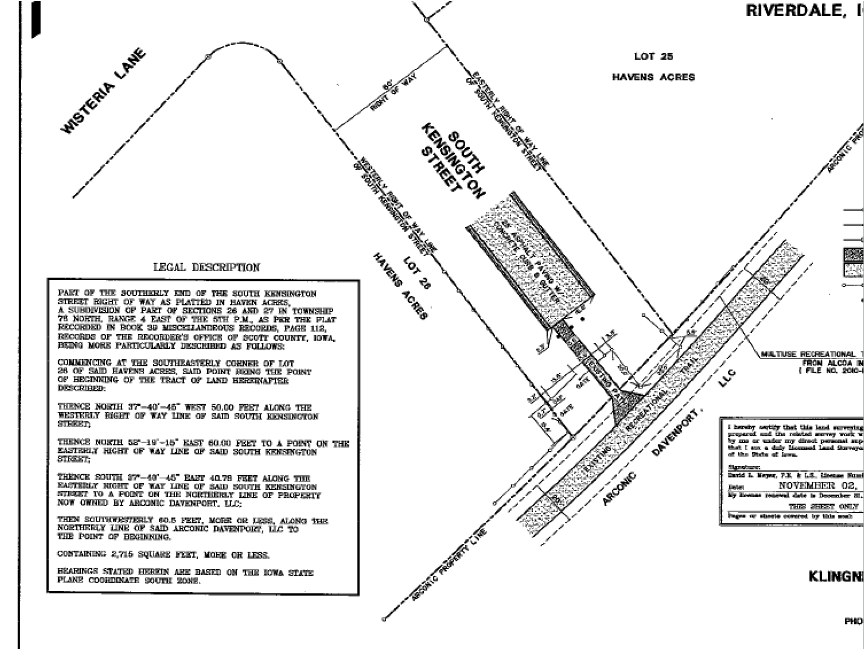by Gary Taylor
Iowa Supreme Court, February 3, 2023
The McNeals were operating a vehicle repair and salvage business on property in Wapello County zoned R-1 Residential. For our purposes it’s not necessary to go too far into the history of the dispute between the McNeals and the county over the condition of the property; it is sufficient to know that in April 2019 the parties entered into a settlement agreement that, in part, included the following provisions:
1. The McNeals have 90 days from April 1, 2019 to clean the Property including the removal of debris and derelict vehicles and begin repairs on the residence . . . .
2. Forty-five days after April 1, 2019, (May 16, 2019) the McNeals grant to the County the right to enter onto the Property and to determine what remaining debris, derelict vehicles, or repairs need to be completed. The County will then notify the McNeals of the additional work which needs to be completed within the 90 day period.
3. If the removal of debris, derelict vehicles, and maintenance of the Property has not been completed to the satisfaction of the County by the end of the 90th day (June 30, 2019), then the McNeals grant unto the County the right for the County and/or its agents to enter onto the Property and to remove all remaining debris, derelict vehicles, and unrepaired structures. The County’s cost in removing such debris, derelict vehicles, or structures will be assessed against the Property ….
4. . . . Other than the procedure set forth in this Settlement Agreement, the McNeals waive and release any other statutory or common law right to challenge the County’s right to enter the Property and to conduct clean up activities, including any rights against the County’s employees, elected officials, or agents….
6. This Agreement is the entire agreement between the Parties and supersedes all prior discussions, understandings or representations. It may not be modified or amended, nor any waiver of its provisions, except by a written instrument executed by the parties.
emphasis added in Paragraph 3
When the county zoning administrator entered the property on May 19 no cleanup work had been done. He sent a letter to the McNeals on May 21 documenting this fact. On August 5, after the ninety-day period referenced in Paragraph 3 of the settlement agreement, plus another thirty-five days, had passed, the county entered the property and removed a large number of items. This included sixteen vehicles, none of which displayed any indication of being licensed. The county sent the McNeals a letter on August 27 advising them that they could retrieve any of the vehicles by providing an indication of title and paying the towing and storage fees, but none could be returned to the same property. The letter also stated that the vehicles would be destroyed if not retrieved within 10 days.
The McNeals filed suit in district court against the county on September 6, claiming that the county’s actions constituted a breach of the settlement agreement. At a hearing on motions filed by bother parties the dispute was determined to be centered on Paragraph 3 of the settlement agreement; specifically on what the term “derelict” meant for purposes of the agreement. The county argued that the language of Paragraph 3 gave the county sole discretion to determine whether the vehicles were “derelict,” while the McNeals disagreed, and countered that there were genuine issues of fact about whether the vehicles were, in fact, derelict. After some actions at the district court and the Court of Appeals that you probably don’t care about, the Iowa Supreme Court took up the case and issued this opinion.
The court stated the issue as primarily an interpretation of Paragraph 3: “What does it mean to say that ‘the removal of debris, derelict vehicles, and maintenance of the Property has not been completed to the satisfaction of the county'”? The county argued, first, that “to the satisfaction of the county” means what it says; that is, it is within the county’s sole discretion to determine whether vehicles were “derelict.” Second, that Paragraph 2 giving the County “the right to enter onto the Property and to determine what remaining debris, derelict vehicles, or repairs need to be completed” affirms this. Third, that to decide otherwise would, in effect, render the “settlement” meaningless as it would give the McNeals the right to essentially relitigate the case over whether the county had the right to remove the items on the property. The McNeals, of course, disagreed with the county’s characterization of the agreement’s provisions.
The Court noted that, absent a phrase in the agreement such as “as determined by the County in its sole discretion,” the relevant inquiry should be “whether a reasonable person in the position of the county would be satisfied” that the McNeals had carried out its obligations under the agreement. The Court concluded that it was reasonable for the county to determine on August 5 that all the vehicles in question were derelict and should be removed. None had current licensure, most were decades old, most if not all were unable to be driven, and a few even lacked VINs. The McNeals had done nothing to clean up the property since the agreement was reached, and offered no proof, either to the county or during the court proceedings, that any of the vehicles were in good, running condition. While the McNeals argued that all the cars had “productive value” because they were salvaged for parts and therefore didn’t require removal, the Court said this was immaterial. A party’s “undisclosed, unilateral intent” in signing a settlement agreement doesn’t matter. A reasonable person could still view a vehicle as derelict even if it had salvage value.
In sum, the Court concluded that the terms of the agreement required the county to act reasonably in determining whether the vehicles were derelict, and that it had done so.

